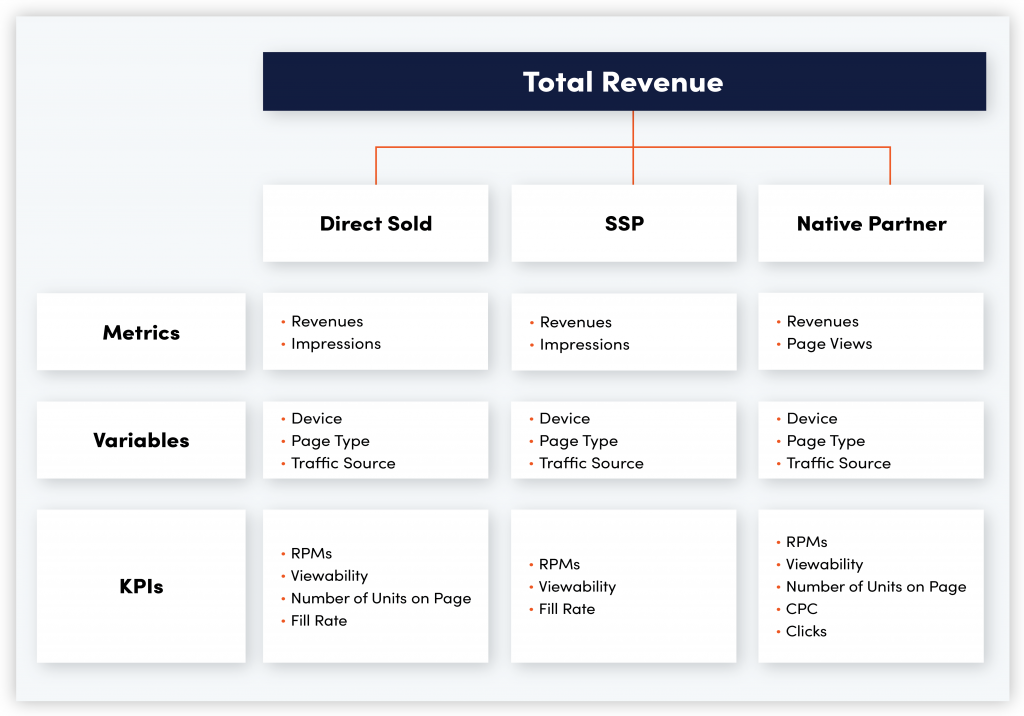[Publisher Series] Revenue Optimization, Part I: Data Insights & Reporting

Can you believe we’ve officially surpassed three months of working from home? And seemingly, our lives couldn’t be busier, despite continued quarantine restrictions.
While my typical schedule would be filled with building relationships with Digital Publishers and tech companies, these days have taken more of a consultant spin, as many media brands are taking a hard hit, monetarily.
When the COVID-19 pandemic first arrived in the U.S., many digital Publishers were already operating on thin margins. The ad market then took a serious hit as major brands and agencies pulled or delayed campaigns causing a severe drop in RPMs — the revenue generated by Publishers on each page from digital advertising.
In fact, according to STAQ, average U.S. display ad CPM has fallen from a high of $1.34 on March 1st, 2020 to $0.91 on May 3rd, 2020 — a 30% decrease.
Some Publishers’ revenue was temporarily offset by an increase in page views, as interested readers spent more time online. Unfortunately, that short reprieve has mostly ended with page views back down to normal.
Meanwhile, Publishers in niche categories like Sports, Travel, and other heavily impacted activities, have been decimated with both low page views and low ad rates. As a result, many Publishers are now in survival mode, planning for the worst by cutting back costs, furloughing staff, and extending payables to preserve as much cash as possible.
Thus, the Revenue Optimization Series
At Outbrain, we’ve been working non-stop with existing (and prospective!) Publishers to fill those revenue and cash-flow gaps by helping to increase engagement, test layout optimizations, and identify additional ways to help each other through this unusual crisis.
Now that cities are slowly beginning to open up, Publishers should take note of their situation and reset a path to maximizing revenue. And to help, we’re going to share tips and approaches utilized by some of our best-of-breed Publisher partners, focusing on both short and mid-term optimizations that can be done without affecting editorial initiatives or integrity, as this is sacrosanct.
So, welcome to our Publishing & Media Revenue Optimization Series, where we’ll review revenue in three main variables:
- RPMs (Revenue Per Thousand Impressions)
- Page Views Per Visit
- Traffic (Visitors)
Revenue = RPMs x Page Views | PV/Visit x Visitors
This simple structure will help identify gaps, set up optimizations, and maximize overall revenue. Before we jump into the first variable, we’ll begin the series by covering data, which is critical for optimizations. And we’ll finish it off with long-term planning to help Publishers prepare for future potential crises.
Revenue Impact Series — What to Expect:
- Part 1: Reporting, Data, and Insights
- Part 2: Optimizing Existing Revenue Sources + RPMs
- Part 3: Optimizing Existing Page Layouts Without Redesign
- Part 4: Optimizing Traffic Sources
- Part 5: New, LTV-Driven Revenue Planning
Since we work with Publishers of all sizes, we’ll provide both “basic” and “advanced” recommendations so readers can quickly identify what may be relevant. “Basic” includes suggestions that should be done right away or apply to smaller Publishers. “Advanced” provides further recommendations for more complex setups.
Why Now?
No Publisher should have to choose between paying its staff or bringing important information to their community. We see Publishers struggling with the same issues our best-in-class Publishers did years back. By sharing the knowledge gained, we aim to support Publishers’ efforts and ensure their viability. After all, in this climate, there’s no room for error.
Let’s jump into Part I then, shall we?
Part I: Data Insights & Reporting
Poynter estimates that over 100 newsrooms, mostly local, have enacted furloughs, layoffs, or closures in the past few months. With persistently low marketing budgets and a highly competitive environment, Publishers not optimized to maximize revenue have a difficult road ahead.
As we lay the groundwork for optimizing your RPMs, Page Views Per Visit, and Traffic to help make this road a bit less bumpy for you, it’s critical that you first identify quantifiable and measurable revenue drivers.
Data: Basics
Revenue data, used to make optimizations, should be broken down into as many levels as possible to provide sufficient insights for decision-making.
In breaking revenue down to its core elements, we need to ensure the data covers three quantifiable and measurable components: Sources, Metrics, and Key Performance Indicators.
Sources
Publishers derive revenue from various sources of which advertising is still a large percentage. Ad sources typically include Directly Sold (i.e. Display and Promoted), Open Programmatic Display and Video (i.e. SSPs), and Native Partnerships. Thus, Publishers should first look at breaking down revenues by Source and reconcile each with the accounting department’s actual revenue received. This will ensure data from each Source is reported properly and no revenue gaps exist.
Metrics
Once verified, revenue Source data needs to be further broken down into core metrics. These are high-level measures typically used for corporate reporting, including Revenue, Users, and Page Views. Since different audiences consume content via different devices — namely Desktop, Mobile, and Tablet — platforms (e.g. Web, Apps, AMP) and traffic sources (e.g. Search, Facebook, Direct), core metrics should be further broken down by each of these variables.
Key Performance Indicators
KPIs provide tactical measures to set goals that generate the desired effect, for example, maximize revenue. One key KPI used by Publishers focused on maximizing revenue is RPM (Revenue Per Thousand Impressions). By maximizing RPMs, a Publisher will maximize revenue. Or, at least that’s the theory. The reality, though, is that there are many interdependencies, so maximizing one revenue source may actually hurt revenue from other sources thereby reducing overall revenue. More on this in Part II!
The chart, below, shows a framework for how a Publisher could break down Revenue by Source, Metrics, Variables, and KPIs.

Data: Advanced
Advanced Publishers will break down metrics even more granularly and across more revenue types (e.g. Subscriptions), revenue sources, audience, page types, and elements leading to more complexity.
The challenge they face is being able to isolate each revenue source or type to optimize individually, while not materially affecting other sources.
Advanced Publishers should identify and separate leading vs. lagging indicators. For example, last month’s page views is a lagging indicator because it represents a historic value that helped contribute to last month’s revenues. However, an increase in unique visits could be a leading indicator if those visitors return next month and consume the average number of page views per visit. Other leading indicators include CPC, CTR, and Fill Rate.
By identifying which metrics and KPIs are leading vs. lagging indicators and prioritizing each, Publishers can first focus optimization efforts on key measures.
Looking at KPIs, advanced Publishers differentiate by identifying “common denominators”, enabling them to compare different revenue sources and placements to each other. For instance, a Video unit near the top of a page will generate higher RPMs — not only because of the ad type — but because it’s near the top and may have a higher viewability rate. When comparing RPM performance, Publishers should compare vRPMs (viewable RPMs) between units to determine which performs best. This measure is probably more important than just RPM when doing multivariable testing and page layout or ad unit placement optimizations.
Apart from the KPIs and metrics listed above, it’s continuously surprising how little Publishers know about the performance of non-revenue links such as Previous/Next buttons, social shares, or editorial tags. These units are part of every page and can negatively impact revenue if not carefully placed. Publishers should keep in mind that understanding the performance of every link and every space on a page is critical to proper decision-making.
Regarding user engagement, advanced Publishers with revenue from Subscriptions, eCommerce, Events, and other non-ad types should understand user behavior and know the lifetime value of a user. Engagement KPIs such as scroll depth, and the number of page views per session — each broken down by user segments — will help Publishers identify different user behaviors to help establish LTVs. As one major publisher put it, “We’re moving away from scale metrics (e.g. page views) to metrics that reflect user experience (e.g. “active” time on site).”
It’s well known that subscribers coming to a site will consume more content per visit than unique visitors coming from a social site. A Publisher should be able to ascertain how much revenue each subscriber visit generates the Publisher to derive an LTV for Subscribers and Non-Subscribers that come from social. This information will be even more critical when we discuss ways to optimize revenue sources and traffic.
Winding Down
The first step to any strategic choice or tactical optimization is to have a keen understanding of the underlying data.
From a revenue perspective, Publishers need to break down each revenue source, metric, and KPI as granularly as possible in order to have a full understanding of how each affects overall revenue. As some of these are interdependent, Publishers need to find common metrics, such as viewable RPM, to compare disparate sources and placements objectively.
Now that we have a good understanding of our performance data across various sources of revenue, we’ll look at a few ways to increase revenue — simply by optimizing existing or comparable revenue sources.
In the meantime, consider discovering how you can manage, control, and monetize your content on the Open Web.


